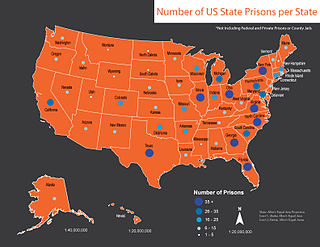
The League of American Bicyclists (LAB), officially the League of American Wheelmen, is a membership organization that promotes cycling for fun, fitness and transportation through advocacy and education. A Section 501(c)(3) nonprofit organization, the League is one of the largest membership organizations of cyclists in the United States.
The list of state parks in the United States are listed by individual state.

This is a list of lists of U.S. state prisons (2010) :

The territory of the United States and its overseas possessions has evolved over time, from the colonial era to the present day. It includes formally organized territories, proposed and failed states, unrecognized breakaway states, international and interstate purchases, cessions, and land grants, and historical military departments and administrative districts. The last section lists informal regions from American vernacular geography known by popular nicknames and linked by geographical, cultural, or economic similarities, some of which are still in use today.
This article contains a list of station stops made by the first Freedom Train on its 48-state tour.

The National Register of Historic Places in the United States is a register including buildings, sites, structures, districts, and objects. The Register automatically includes all National Historic Landmarks as well as all historic areas administered by the U.S. National Park Service. Since its introduction in 1966, more than 97,000 separate listings have been added to the register.
The following is a set–index article, providing a list of lists, for the cities, towns and villages within the jurisdictional United States. It is divided, alphabetically, according to the state, territory, or district name in which they are located.

The National High School Hall of Fame is a program of the National Federation of State High School Associations (NFHS) that honors individuals who have made outstanding contributions to high school sports or performing arts. As of 2019, a total of 482 individuals have been inducted since the first class in 1982. Because there is a huge pool of potential candidates, it is considered a very exclusive hall of fame.
Living Legends, originally the Lamanite Generation, is a song and dance performing group at Brigham Young University made up of performers of Native American, Polynesian and Hispanic or Latino origin. They perform dances that originate in these cultures as well. Living Legends was formed in 1971 by Janie Thompson.
In the United States, the first full week of September is designated National Blood Donation Week. Established in 2016, the week United States is to hold individual state blood donation days. This serves to assist blood banks all over the country to keep their shelves full and to raise awareness of the continual need to donate blood and blood products. September 4th of the week holds most of the states' blood donation days, and is known as National Blood Donation Day.
National Blood Donation Day comes each year on September 4. It is an observance during National Blood Donation Week and campaign that highlights the need for blood. Multiple states throughout the United States have their state blood donation day on this same day uniting the country in its effort to keep blood banks and hospitals stocked.
This page is based on this
Wikipedia article Text is available under the
CC BY-SA 4.0 license; additional terms may apply.
Images, videos and audio are available under their respective licenses.




